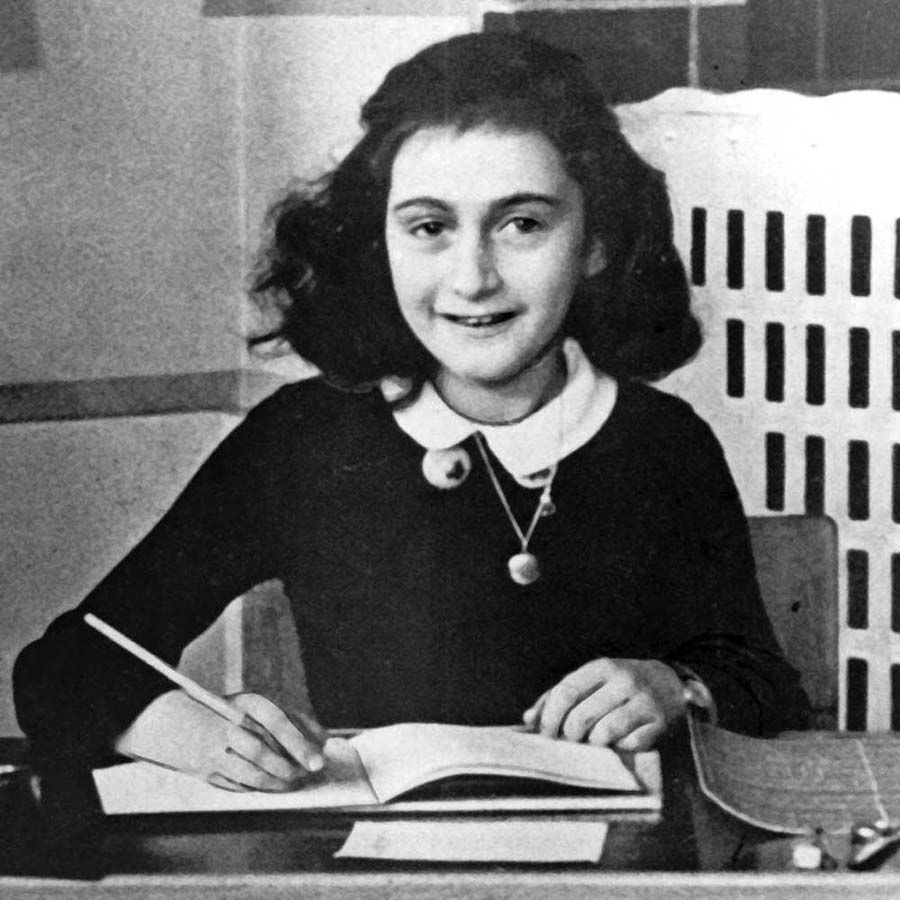I first bought “The Diary of Anne Frank” for a dime at a church rummage sale in North Hampton, New Hampshire. I was 10, and when I finished, I went around for weeks thinking, I can’t believe they killed her. That Nazi death camp was my first introduction to real evil. I’m not over it yet. I hope I never will be.
The Museum of Tolerance recently opened a new interactive exhibit, called simply “Anne,” billed as “a 60-minute experience” that “brings Anne’s story to life through immersive environments, multimedia presentations and intriguing displays.”
Along the entrance hallway, a blown-up photo of Anne faces a window giving on to the Hollywood Hills. She loved the movies and always longed to see where they were made. At last, her wish has come true.
First: A timeline of Anne’s life. The Frank family lived in Frankfurt, Germany, until 1933. They viewed Germany as their homeland. Anne’s father, Otto, served proudly in the German Army during WWI.
A short film, in which Hitler looks psychotic, describes the Germans coming to power.
As anti-Jewish sentiment rose, Otto went to Amsterdam to search out a new place for the family to live. A photographic mural of the canals of Amsterdam shows homes, businesses and the fishing industry.
A film of Bernd “Buddy” Elias, the last remaining living member of the Frank family: “Anne was lively.” “We were Jewish but not religious.” “We were always a writing family.” “We wrote letters to each other every second day.”
Otto believed he’d be safe in a neutral country. His hopes were dashed when the Nazis invaded and occupied the Netherlands in May of 1940.
On July 6, 1942,eight people went into hiding: Anne, her older sister Margot, their parents Otto and Edith, and four others. A video shows the Secret Annex as it would have been furnished while they lived there. The walls of Anne’s bedroom are covered with photos of movie stars. She loved “Cinema & Theater,”and a Dutch fashion magazine called Libelle.
And as the world knows, while in the Annex, Anne began to write a diary.
“One day this terrible war will be over.”
In a screening room, a video of Anne’s writings are read by actress Hailee Steinfeld. Of a friend who appeared to her in a dream, Anne wrote: “Why should I be chosen to live and she, probably, to die?”
Another glass case with board games, soap, matches, candles, linoleum wax and a shaving stick from Amsterdam during WWII, as well as ration cards, coins, and “Palestine at the Crossroads,” a book Anne read in the Annex.
“Nearly every morning I go to the attic to blow the stuffy air out of my lungs, from my favorite spot on the floor I look up at the blue sky and the bare chestnut tree, on whose branches little raindrops shine, appearing like silver, and at the seagulls and other birds as they glide on the wind. As long as this exists, I thought, and I may live to see it, this sunshine, the cloudless skies, while this lasts I cannot be unhappy.”
Betrayal: “The raid of Friday, Aug. 4, 1944, was almost certainly the result of deliberate betrayal, although it has never been proven. Julius Dettmann, who received the phone call tip at SD headquarters and immediately dispatched the arresting officers, committed suicide shortly after the war…”
Videos of arrest, deportation, the bunkers at Auschwitz. A hand turning on the gas; the mass graves.
On Sept. 3, 1944, Edith, Anne, and Margot were sent from Westerbork to Auschwitz. Thus the three were together for a few weeks.
Edith stayed at Auschwitz; at the end of October, 1944, Margot and Anne were sent to Bergen-Belsen. My docent, Linda, told the story. Edith had a feeling, a hope that the girls would come back. So she saved what she could of her rations, stashing the food away for when the girls came back. They never did, of course. And Edith died of starvation.
Margot died of typhus and deprivation in March, 1945. She had just turned 19. Anne died a few days later just a few weeks before British troops liberated the camp. The exact dates of death of both are unknown.
“I want to go on living after my death.”
In 2007 the chestnut tree Anne had seen from the Annex, weakened by disease and a moth infestation, was ordered to be cut down. A controversy arose. Injunctions were filed. There the tree stood until a 2010 storm finally blew it over. But growing from the stump below where it broke was a small side shoot. Eleven saplings have been distributed to U.S. schools and museums. If all goes well, Anne Frank trees will one day grow all over the world.
“Will I ever be able to write something great?”
“The Diary of Anne Frank” first appeared, in the Netherlands, in 1947. Dutch journalist and historian Jan Romein observed: “This apparently inconsequential diary by a child, this ‘de profundis’ stammered out in a child’s voice, embodies all the hideousness of fascism, more so than all the evidence of Nuremberg put together.”
“Will I ever become a journalist or a writer?”
The diary has been translated into 67 languages. Over 31 million copies have been sold.
Interested in more? Subscribe to Angelus News to get daily articles sent to your inbox.
The Museum of Tolerance, Simon Wiesenthal Plaza, 9786 West Pico Blvd., Los Angeles. For more information, call(310) 553-8403 or visit www.museumoftolerance.com.

